A Vision for Coastal Ecosystem Research
Coastal ecosystem science is the study of inter-relationships among the living organisms, physical features, bio-chemical processes, natural phenomena, and human activities in coastal ecological communities. At NOAA's National Ocean Service, coastal ecosystem science centers on the study of five categories of ecosystem stressors, including climate change, extreme natural events, pollution, invasive species, and land and resource use.
- Introduction
- Estuaries: Land and Water
- Sanctuaries: Marine Parks
- Coral Reefs: Rainforests of the Sea
- Coastal Oceans
- Conclusion
Sandy beaches, diverse estuaries, colorful and bountiful coral reefs, expanses of coastal waters. Many of us visit or live on or near coastal and marine areas and rely on the resources that these areas provide. However, coastal and marine resources are not endless in supply and our continued use and enjoyment of these resources is contingent upon their protection and wise management. NOAA, by working to understand, monitor, and predict environmental changes, provides the tools needed to conserve and manage coastal and marine resources while balancing our nation's economic, social, and environmental needs.
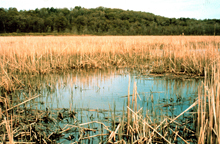
NOAA conducts research to manage and protect areas such as the Hudson River National Estuarine Research Reserve at Piermont Marsh, just over 20 miles from New York City. This reserve is home to more than 200 species of fish and serves as a nursery ground for such important fish as sturgeon, striped bass, and American shad.
The coastal and marine ecosystems NOAA protects represent complex environments, featuring an interwoven matrix of organisms and physical environmental features—changing even one element in this matrix can impact the entire ecosystem. Resource managers, the scientific community, and increasingly the public, are recognizing the need for scientists from multiple disciplines to work closely together to support management and stewardship responsibilities. In the coming years, such an integrated approach to NOAA's understanding, monitoring, and predicting environmental change is going to become increasingly necessary as conservation and management issues become more complex.
What follows is a brief glimpse into some of the coastal science activities NOAA will pursue over the coming years.
Estuaries: Where Land and Water Intertwine
The nation's coasts and estuaries need to be managed, understood, and appreciated on many levels. Through a network of locally oriented programs around the country, NOAA's National Estuarine Research Reserve System (NERRS) provides information; management insights and training; and data for use by local, regional, and federal scientists and decision makers. Working at both the individual estuary level and as a national system, NERRS has had a greater impact than that which could have been achieved through community efforts alone.
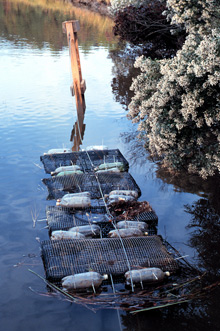
Oyster floats growing oysters in Taskinas Creek, Chesapeake Bay Virginia National Estuarine Research Reserve, as part of the Aquaculture Education Project. Click image for larger view.
As we move to the future, land use and population growth, deteriorating water quality, habitat loss and alteration, and changes in biological communities are four issues that will need immediate attention from this national system. These issues are high-priority science and training needs for coastal managers, and NERRS scientists, educators, and land managers have identified these topics as locally and nationally important. Increased understanding about these issues will improve the reserves' ability to protect and restore coastal watersheds and estuaries and empower individuals to make informed decisions.
In the future, NERRS scientists will continue to conduct research on items that have a high local priority. For example, scientists have developed an automated system for monitoring Harmful Algal Bloom (HAB) species in the Mission Aransas Reserve, Texas, Called Imaging FlowCytobot, this system analyzes water particles every 20 minutes and uses automated image classification software to categorize particles. These frequent measurements, carried out over a long duration of time, offer unprecedented opportunities to monitor bloom events from beginning to end.
To expand knowledge of issues in estuaries, NOAA will also continue to offer research fellowships to support research priorities while simultaneously training future estuarine scientists. Such fellowships also address another key to managing future challenges: ensuring that there is a knowledgeable workforce available to study and make decisions about estuaries.
Sanctuaries: Marine Parks

A Manta Ray blocks out the sun at the Flower Garden Banks National Marine Sanctuary. Click image for larger view and full caption.
NOAA's National Marine Sanctuary Program protects a system of 14 underwater parks encompassing more than 150,000 square miles of marine and Great Lakes waters. Science and exploration are fundamental to the National Marine Sanctuary Program's mission to conserve, protect, manage, and maintain some of the most complex ecosystems on Earth. Through continued scientific research, monitoring, and characterization, Sanctuary staff and partners provide the knowledge necessary to manage these vast resources. Beyond sanctuary borders, the rich collection of information from science expeditions and studies is shared with other communities and countries, strengthening protection and management of marine resources worldwide.
In the coming years, the Sanctuary Program will unveil the next generation in visitor center design. Three national marine sanctuaries broke ground on discovery and learning centers in 2004. The Florida Keys Eco-Discovery Center, in Key West, Florida, opened in 2007 and features 6,000 square feet of interactive exhibits that allow visitors to learn about the Florida Keys. A new 4,625-square-foot community education and learning center was opened in 2006 at the Hawaiian Islands Humpback Whale National Marine Sanctuary in Kihei. Also in 2006, Thunder Bay Sanctuary in Alpena, Michigan, completed construction of a new Maritime Heritage Center. These centers, like several others already in operation, will reach millions, enhancing public awareness, understanding, and appreciation of the country's ocean and Great Lakes ecosystems and maritime heritage.

Visitors learning about an intertidal region at the Gulf of the Farallones National Marine Sanctuary. Click image for larger view.
The Sanctuary Program strives to work closely with local communities and all interested parties to accurately assess and manage sanctuary resources. In the future, the program will assess, enhance, and add to the number of partnerships already in place. For example, in March 2004, the program announced a new partnership with the American Zoo and Aquarium Association, a nonprofit organization dedicated to the advancement of zoos and aquariums. The association consists of 213 member institutions that receive 142 million visitors annually. The association is helping the Sanctuary Program connect with aquariums across the country to enhance public awareness of the marine environment through NOAA educational programs and exhibits. Partnerships such as these will continue to be important in raising public awareness and appreciation of marine sanctuaries.
Other future goals for the Sanctuary Program include identifying over 1,000 shipwrecks within the boundaries of several sanctuaries. These shipwrecks are national, historical, and cultural treasures which should be documented.
Coral Reefs: Rainforests of the Sea
NOAA has developed several initiatives to study and address declining coral reef health seen in recent years. For example, Coral Reef Regional Ecosystem Studies, a new long-term, ecosystem-level research program developed by NOAA and the U.S. Department of the Interior, examines interactions between land-based activities and coral health. NOAA's Coastal Ocean Program developed a five-year research program to define and understand causes and effects of reef degradation and provide managers information and tools to aid in reversing the degradation of U.S. Caribbean reef ecosystems. Continuing programs such as these in the future will help NOAA better understand and manage impacts to coral reefs in order to protect these ecosystems.

Elkhorn coral and a white-spotted filefish. NOAA scientists are working on defining and understanding causes and effects of reef degradation to provide information and tools to aid in managing impacts to coral reefs in order to protect these ecosystems. Click image for larger view.
NOAA performs inventories, develops maps, and monitors coral reef ecosystems using computer and remote sensing technologies that inexpensively map coral reef ecosystems with increased speed and accuracy. Using these emerging technologies, NOAA leads federal efforts to map all U.S. coral reefs by 2010. NOAA's National Centers for Coastal Ocean Science (NCCOS) organizes and coordinates U.S. scientific resources and assets to focus on coral health issues, such as developing diagnostic capabilities and determining biomolecular mechanisms of coral bleaching. This research will allow managers to forecast bleaching events and try to lessen the impact of conditions that threaten coral health.
NCCOS is working with partners within NOAA, other federal agencies, states, tribes, territories, commonwealths, universities, industry, and non-profit organizations to create coordinated, long-term, national programs to inventory species, assess conditions, monitor trends, and predict changes in U.S. coral reef ecosystems. These programs provide decision makers with key information to respond to changing environmental conditions.
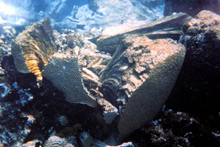
A brain coral split apart by the Fortuna Reefer grounding off Mona Island, Puerto Rico. Ship groundings are serious threats to coral reefs. Click image for larger view and full caption.
While coral reef managers cannot directly affect the root cause of large-scale threats, such as hurricanes or coral bleaching, managing to support coral reef resilience is emerging as a response strategy, similar to boosting the human immune system to prevent disease. Resilience is the natural ability of corals to survive and recover from stresses in the natural environment. In December 2004, NOAA partnered with the world's preeminent coral managers with the goal of improving coral reef resilience in the Florida Keys National Marine Sanctuary and Great Barrier Reef Marine Park (Austraila). This partnership will emphasize coordinating scientific research, exchanging information on emerging management strategies, and developing joint projects.
Coastal Oceans
NOAA science aims to respond directly to coastal managers' needs by providing them with scientifically sound information and management tools and techniques. Specifically, NOAA translates its scientific results into ecological forecasts, which provide managers with precise, practical information to help them make more informed decisions.
For the last eight years, NOAA and federal, state, and academic partners have made considerable progress in the scientific understanding, detection, monitoring, assessment, and prediction of harmful algal blooms (HABs) and hypoxia (low oxygen) in coastal ecosystems. These advances are helping coastal managers undertake short- and long-term efforts to prevent and mitigate the detrimental effects of these phenomena on human health and coastal resources. NOAA continues to build on these past successes with regional expansions of HAB monitoring and forecasting capacity in both marine and freshwater environments and new methods for prevention, control, and mitigation.
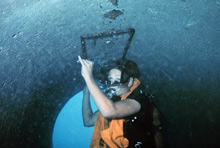
A diver installs a one-quarter-square meter grid for counting invertebrate species. This location was a distinct habitat type ideal for larval settlement of oysters, sponges, bryozoans, and tunicates. Click image for larger view.
NOAA also works to understand and anticipate changes in coastal ecosystems as they become stressed. For example, NOAA investigators are studying the warmer bottom water temperatures found along the continental shelf off North Carolina and how these temperatures are affecting the species living there. There is already some evidence of a shift toward fish species typical of more southerly latitudes at a NOAA-study site off North Carolina. In addition, a tropical species, the invasive Indo-Pacific Lionfish, is not only surviving, but thriving, in North Carolina coastal waters.
NOAA is also evaluating different habitat restoration techniques for seagrass beds, oyster beds, and coral reefs.
Conclusion
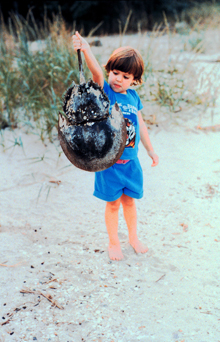
A young naturalist inspects an empty horseshoe crab shell. The future of coastal ocean science, ever-building on research from the past, depends on continued generations of the curious well into the future.
It is increasingly apparent that coastal and marine ecosystems are not in a steady state and that resource managers must be prepared to adapt to changing conditions. In addition to the importance of annual- to decadal-scale climate variability to ecosystems, other changes are predicted to have increasingly significant effects over the next 15 years. NOAA and its partners have a lot of work ahead of them in the coming years, to better understand, monitor, and predict the ever-changing coastal environment.
